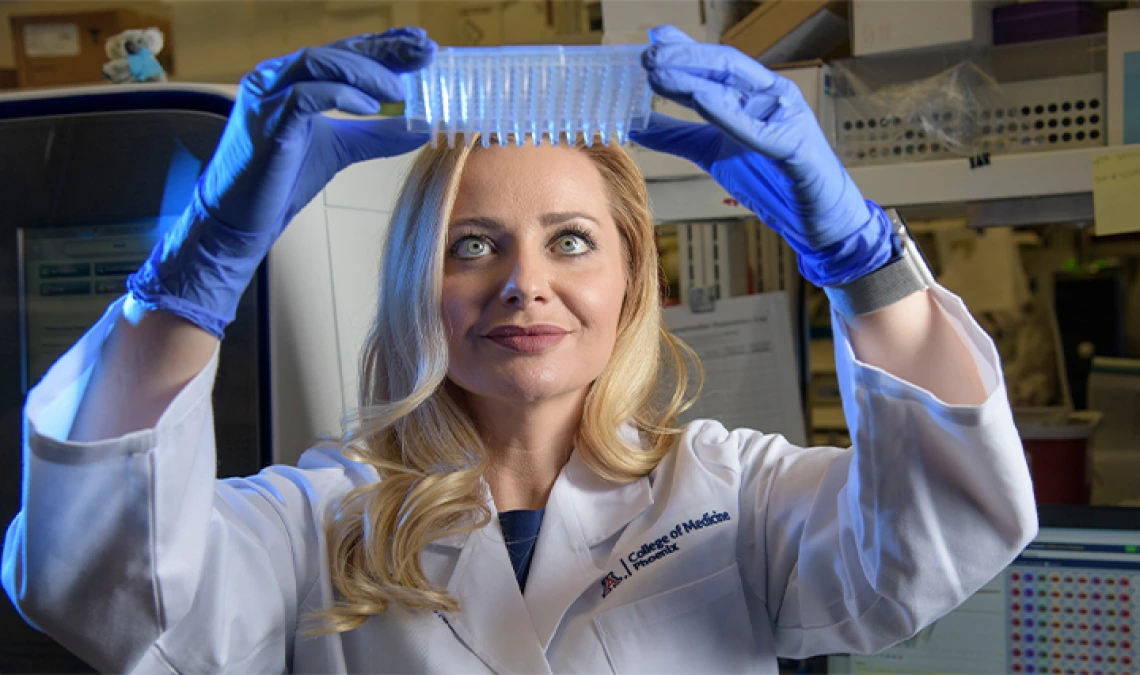|
TUCSON, Ariz. – University of Arizona Health Sciences researchers’ quest to better understand the vaginal microbiome and its role in human papillomavirus (HPV) infection, which may progress into cervical cancer, has revealed potential new targets for early detection and monitoring treatment – proteins known as immune checkpoints.
Immune checkpoints regulate a patient’s immune system and can dictate recognition and elimination of cancer cells. Presence and implications of these proteins in the cervicovaginal environment, however, had previously not been studied, said Melissa Herbst-Kralovetz, PhD, associate professor of basic medical sciences and obstetrics/gynecology at the UArizona College of Medicine – Phoenix , and director of the Women’s Health Research Program, as well as a member of the UArizona Cancer Center.
Dr. Herbst-Kralovetz and researchers in her lab continue to untangle the complexities of the vaginal microbiome , seeking to harness the microbiome or other features of the microenvironment to better detect, prevent and treat gynecologic cancers, such as cervical cancer, which can be caused by HPV infection. Their previous investigations have uncovered several potential molecular signals, or indicators, of cancer (known as biomarkers). This led Dr. Herbst-Kralovetz and co-investigator Pawel Laniewski, PhD, to wonder if immune checkpoints also could be detected at this site because these proteins play a key role in attacking or eliminating cancer cells.
“We know immune checkpoint proteins often are overexpressed in the tumor microenvironment, meaning they are increased, which can promote carcinogenesis (cancer development) by not allowing for an effective anti-tumor response,” Dr. Herbst-Kralovetz said. “So we hypothesized these checkpoints also may be at work in the cervicovaginal microenvironment and may be altered with HPV infection, precancer and cancer.”
In a new study published in August in npj Precision Oncology, a journal of the Nature Publishing Group, and referenced in Nature’s “Behind the Paper” blog, Drs. Herbst-Kralovetz and Laniewski discuss their research in collaboration with colleagues from the UArizona Biostatistics Shared Resource, including Denise Roe, DrPH, resource director; Haiyan Cui, PhD , senior research specialist, UArizona Cancer Center; and Dana Chase, MD, a clinical collaborator from Arizona Oncology.
Using cervicovaginal lavages (CVLs), a non-invasive method to collect fluid samples from a patient, the researchers were able to measure the immune checkpoint proteins in the cervicovaginal environment. As a result, they discovered these proteins have the potential to predict whether a woman has dysplasia – abnormal cell growth – or cancer.
“We identified immune checkpoints that specifically and sensitively discriminated cancer patients from healthy women or women with dysplasia,” said Dr. Laniewski, referring to abnormal cell growth on the lining of the cervix or endocervical canal – the pathway from inside the uterus to the vagina. “Intriguingly, we also found that women with genital inflammation, or unhealthy vaginal bacteria, also have elevated specific immune checkpoints, suggesting these features of the local microenvironment also might contribute to cancer progression.”
“In addition to the promising evidence that reveals new biomarkers, this study highlights the potential utility of CVL profiling for predicting and monitoring response to therapy,” Dr. Herbst-Kralovetz said. “For the individual, a CVL is minimally invasive and even easier than a blood draw. This also could evolve into a self-collected sample, like a swab.”
These findings, combined with previous and other ongoing studies, provide a foundation for future studies for Dr. Herbst-Kralovetz and her research team. They intend to further study immune checkpoints to determine if, in addition to being a tool for early detection, they can be used to monitor and predict responses to cancer therapy.
“I’m incredibly passionate about creating interdisciplinary research teams to build our understanding of gynecologic cancers and the local microenvironment to positively impact women’s health outcomes,” Dr. Herbst-Kralovetz said. “This is a first step for precision medicine approaches for novel diagnostics, and it also may be a way for us to track how patients are responding to treatment.”
# # #
A related story and photo gallery associated with this article can be found on the UArizona Health Sciences website.
NOTE: Photos available here – https://arizona.box.com/s/eamuzz3jrcddz5kwxxw9mypjzx4afny0.
|


